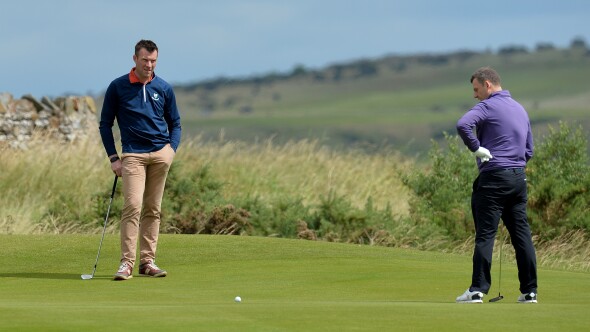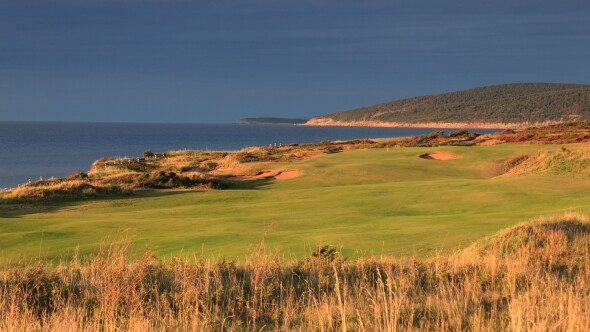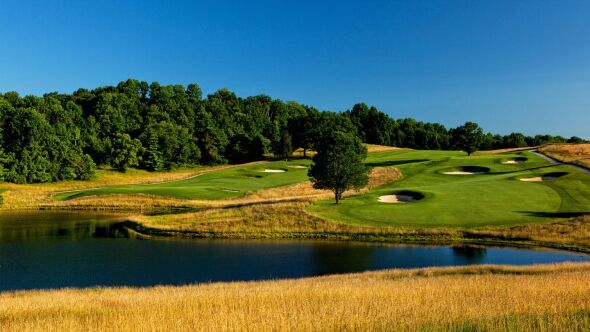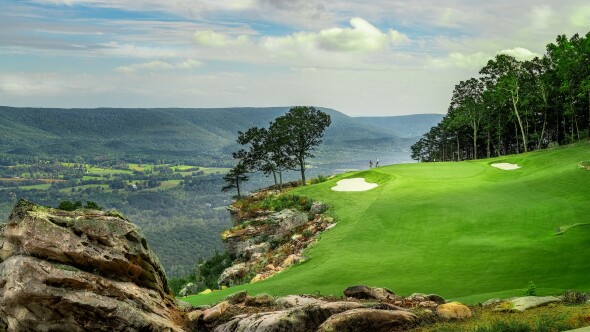The greatest golfer of his era and possibly of all time can still have opinions about the game that are off base. That’s exactly the case with Jack Nicklaus’ argument for rolling back the golf ball. He thinks it will address — even solve — the issue of slow play. He’s wrong, and in the process has confused two issues that are fundamental to the future of the game.
The Golden Bear made headlines last week during the Honda Classic when he said it would make sense to rollback the golf ball "20 percent."
It’s not clear what he’s referring to by that number — velocity, average carry or overall distance. If it’s average overall distance with PGA Tour drives, that would mean a reduction in driving distance from, say, last year’s mean average of 292.5 yards all the way down to 234 yards. That 58.5-yard loss would bring drives back to circa 1960 levels. (In 1980, the first year of officially measured drives on tour, the average was 257 yards).
It’s also not clear what the resulting loss of distance would be for everyday golfers, who swing at slower speeds than PGA Tour players. A reduction in driving distance for everyday players would be an exercise in industrial suicide, a deathblow for an already-struggling business that thrives on the consumer promise of game improvement and longer distance. Try telling your average, male 14-handicapper that his 215-yard drives will now go 185 yards.
Nicklaus seems to think the problem with distance is that it’s causing slow play. The evidence for that claim is scant and fleeting. The closest I have ever seen is a view voiced by course owner Frank Jemsek concerning Cog Hill Golf Course No. 1, part of a multi-course facility the family owns in Chicagoland. Jemsek is adamant that they’ve lost one starting time an hour because of slow play on the opening hole, a par-5 that lots of middle-handicappers think they can hit in two – and so they wait before playing up.
But none of that is relevant to PGA Tour pacing, where a major culprit for slow play is the players who play slowly. Like J.B. Holmes dithering for four minutes and ten seconds before laying up on the par-5 18th hole in Sunday’s fourth round a month ago at Torrey Pines South in San Diego. That might seem extreme (it was), but final rounds of five and half hours are now virtually standard on the PGA Tour.
Maybe it’s too much information-gathering, like your proverbial college kid double-checking his yardage before undertaking his 13-step pre-shot routine. Or the fact that so many elite players don’t even start their elaborate routines until it’s their time to hit. If they would start with shot assessment, yardage determination and club selection while waiting their turn, they could save themselves (and us) 30 seconds a shot.
There’s also the flow of a golf course – less a matter of individual player behavior than a structural issue akin to a manufacturing supply line. The USGA has been relying on a "flow through" model to make considerable headway in pace of play at its national championships. The USGA’s go-to guy in such matters has been a former industrial engineer named Bill Yates, who approaches such matters in the seemingly grim but surprisingly enlightening manner of "input and output."
Video: Nicklaus says Titleist shouldn't be against rollback
If you were to imagine the golf course as an industrial conveyor belt, you’d look for obvious sources of jam-ups and slowdowns. You’d also be careful not to overload the flow. A low-rent operator seeking to maximize tee times would be tempted to station starting times at six-minute intervals. This would quickly overload the course, slow down the place and create endless waits throughout the round.
A more relaxed approach at a private club might see tee time intervals of 12 minutes – thus ensuring a steady flow and no waits during a round. Thus the paradoxical rule of course pace: the longer the tee time interval, the faster the pace and the fewer the jam ups.
The slow pace of modern tournament golf is not a function of distance. Nor will shortening the ball’s overall distance address the problem for everyday golfers.
Along the way, Yates has identified a number of issues that impede the flow of a golf course. His interest is not only in speeding up the game but also in eliminating roadblocks and creating a smooth, consistent flow. It might be awkward crossovers; long walks from certain hole locations to some back tees; the positioning of spectator crossings that impede player movement; heavy rough on the right (slice) side approach area to a long par 4; or routing sequence of a drivable par 4 followed by a long-par 3.
There’s a hint of common sense in Nicklaus’ observations about length and pace, but they are peripheral issues, not central. At a standard course-walking pace of three miles per hour, a 7,000-yard course (3.98 miles) would take one hour and 20 minutes to walk. A 7,500-yard course (4.26 miles) would require one hour and 25 minutes to walk. If we factor in the likelihood of having to walk back to reach the farthest tees before playing a drive, we have to add a few more minutes to the stroll. All told, it does not add up to a discernible difference.
The slow pace of modern tournament golf is not a function of distance. Nor will shortening the ball’s overall distance address the problem for everyday golfers.
Distance and the growing length of championship golf courses is a problem. It’s an issue of acreage, land use, and maintenance for tees that are scarcely in play, and when used (for what I’d estimate to be for less than one-percent of all rounds played) they are played by "industry comps" – mainly pros and college kids.
The real issue with distance is the resulting reduction in skill and variety in shotmaking. When tour players can hit 3-wood/9-iron to a 450-yard hole whereas 30 years ago they needed driver/5-iron to reach the same green, the game suffers and it becomes impossible to test skilled shot making with a full arsenal of clubs. Thirty years ago, nobody hit 600-yard par-5s in two. Now it’s a regular achievement.
Slow play is one thing. Distance quite another. Nicklaus’ suggestion, to solve the former by addressing the latter, ignores the subtleties of both issues. It also punishes everyday players for the sins of the elite golfer.
To do that, we need a golf ball that does not have completely different compression, launch and aerodynamic qualities when crushed at upwards of 112 miles per hour. The real issue is that while we are all playing "the same ball" we are not able to use it the same way because only a small elite corps of golfers is able to swing hard enough to reach and compress the core of the golf ball. The solution, then, would not be to dial back the golf ball but to reduce its maximal performance. Now that would be a feat of engineering equal to the dual task of protecting our courses while respecting the everyday player.
















Excellent illustration of a complex issue.
Hey, I drive the ball as far as the pros did in the 50's! I actually feel pretty good about that.
Id love to see how far DJ, JT, BW could drive the ball with a real wood and a ball from 50 years ago
Isn't the solution for pros to play a different ball to the amateurs? There are already lots of differences between the pro and amateur game. Pros play from different tees. Pros can't wear shorts...it seems more and more that they MUST wear white pants. If the pros used a different ball, the manufacturers can still make the current ball for amateurs and amateurs can still use their favorite pro's brand. And if any amateur actually wants to use a ball that flies 20% less than his playing partners, then so be it.
I hate watching Pro golf on TV these days especially the men because of the time it takes to play 18 holes. The LPGA is not nearly as bad and I usually watch them instead of the men. There is no way that a four player group should take more than an average of 15 minutes per hole and that is on a bad weather day, 4 hours should be max. And of course when you talk about your home course all the guys that watch TV think that if the pros can take that long there is no reason why they shouldn't do the same. I my opinion the ball nor the length of the course has anything to do with time of play. I do think there are two reasons for the slowness. The first reason is the TV coverage as they need the play slowed down so they can get as much sponsorship money as possible. The second reason is the amount of money that the pros are playing for. When the winner gets over one million dollars there is no wonder they take 2 to 4 minutes to make a shot when it should me no more than between 30 and 45 seconds. One easy way to speed up the game, put them on the clock for every shot, putts included, with a max of 40 seconds and a penalty of $5,000. if they take longer. The game would soon speed up and the amateurs would follow suit.
I've been a member of my club 50 years. It hasn't changed much except that it was a great deal faster to play in 1967 than it is now - by about 1 hour on average. I recently joined a second club. It expects everyone to play at a pace of 2 hours 10 mins per 9 holes. If you drop behind even a minute a message appears on your cart screen. Guess what? 18 holes takes 4hrs 20mins or less - almost without exception!
Hahaha. Let's see, who am I going to believe......Bradley S. Klein, Senior Hack or Jack Nicklaus, greatest golfer ever.
1. One look at a putt. No more doing a 360 or checking several angles.
2. Dump the yardage book. Too much time spent analyzing what’s in the book.
Nicklaus does not realize that he is partly responsible for the two worst issues facing golf-- slow play and high cost, two issues that are turning off a large segment of young potential golfers. Jack was himself the first very "deliberate" golfer and he was copied due to success. If Billy Casper had won 18 majors and not Jack, golf would be played a lot faster. Also Jack and his high priced designers are at least part of the problem of high cost. It's time we all stopped worshipping all he has to say.
I don't remember Mr. Nicklaus advocating for this kind of reduction when he was blowing it past everyone during his career. It seems a little disingenuous because the freak of a player he was then is being overshadowed by the "Tiger" kind of player that has evolved over time on the Tour. You can move players along by putting them on the clock and actually fining them when they have a shot clock violation. They'll be kicking and screaming but over a short period of time they will respond accordingly. If you REALLY wanted to speed up play reduce the overall purse of a tournament by 1% per shot clock violation - TV wouldn't be able to keep up with them then - LOL.
I recognize that shotmaking and distances have changed but the ball that Jack used wasn't the ball that Byron used that wasn't the ball that Bobby used that wasn't the ball that Old Tom used either. The fact that technology continues to advance against the finite yardages of golf courses may require caps at some point but dialing back the ball isn't in accordance with the history of the game.
Professionals can play faster if they want to. Back in the 1990's, Craig Perry was in last place on Sunday morning in a Nike Tour tournament in Lafayette LA. His potential playing partner had DQ'd the day before. Though he was offered a marker, he elected to play alone. He stated that he hoped to play quickly in order to catch an early flight to Atlanta for the next tournament on the PGA tour. The course, Le Triomphe, plays about 7300 yards. In addition, many holes have almost 100 yards green to tee as the course winds through a subdivision. In spite of these challenges, he played in about 1:35 and shot 69 (par 72). He appeared in the PGA tournament the following week and was on the leader board, though I can't remember where he finished. He was jogging between shots and sending his caddy ahead while he finished each hole.
Obviously, this is not practical for normal play, but the game could be sped up. Allowing the use of GPS for yardage would save a great amount of time without giving any player an unfair advantage. Putting players "on the clock" (like the NBA shot clock) would also improve pace of play. The clock would start after the player reached his ball and it was safe to play. A player could be given a limited number of "time outs" for rulings. These changes could easily reduce time to play a round by 15 -20 minutes.